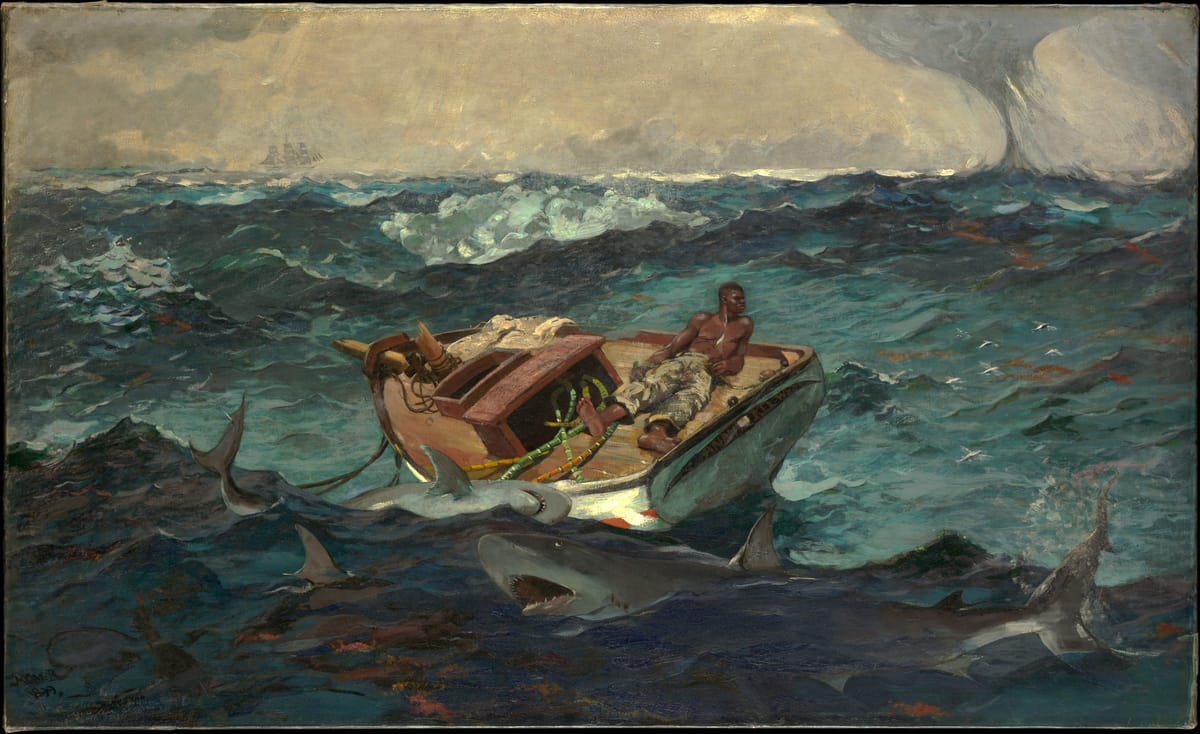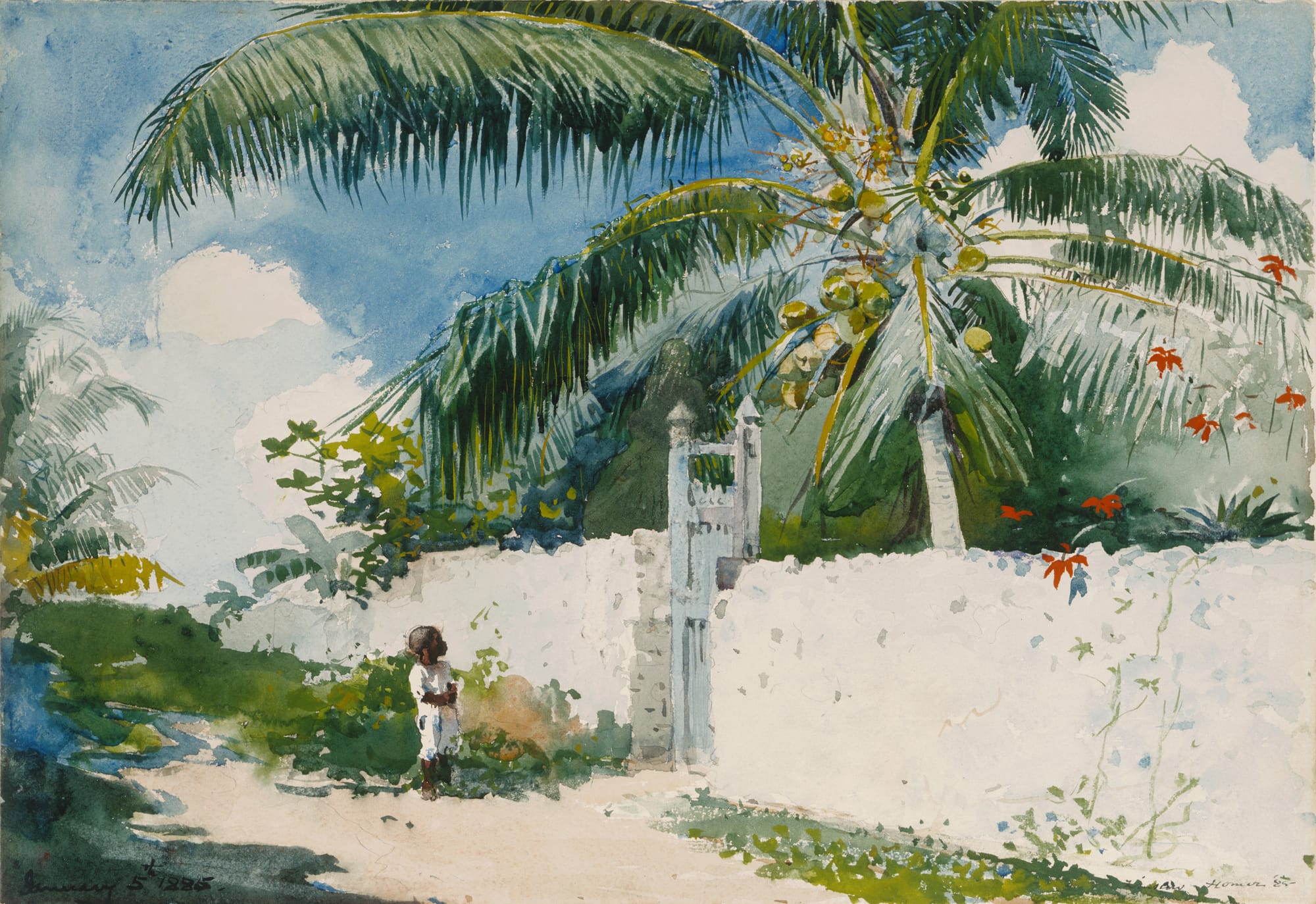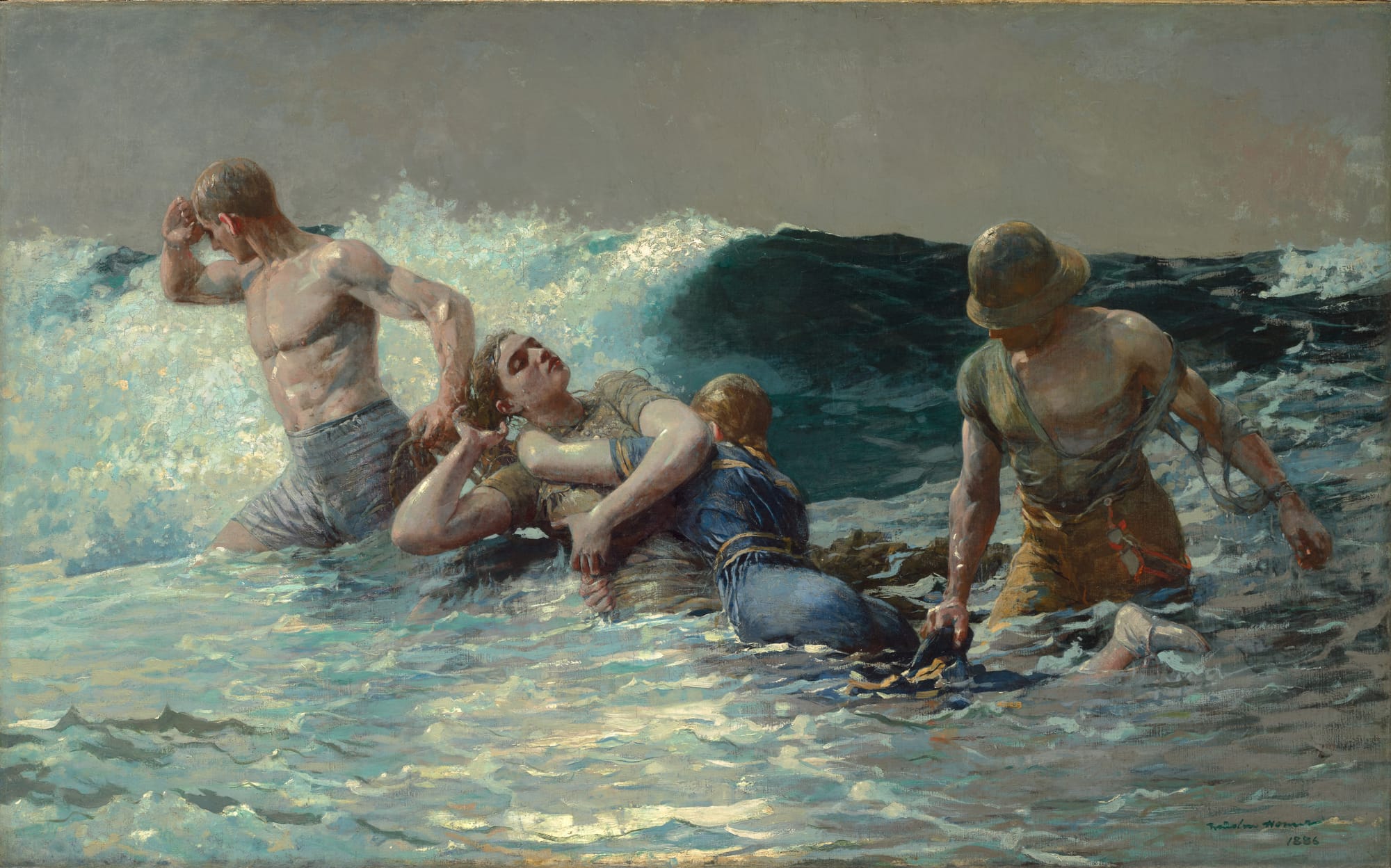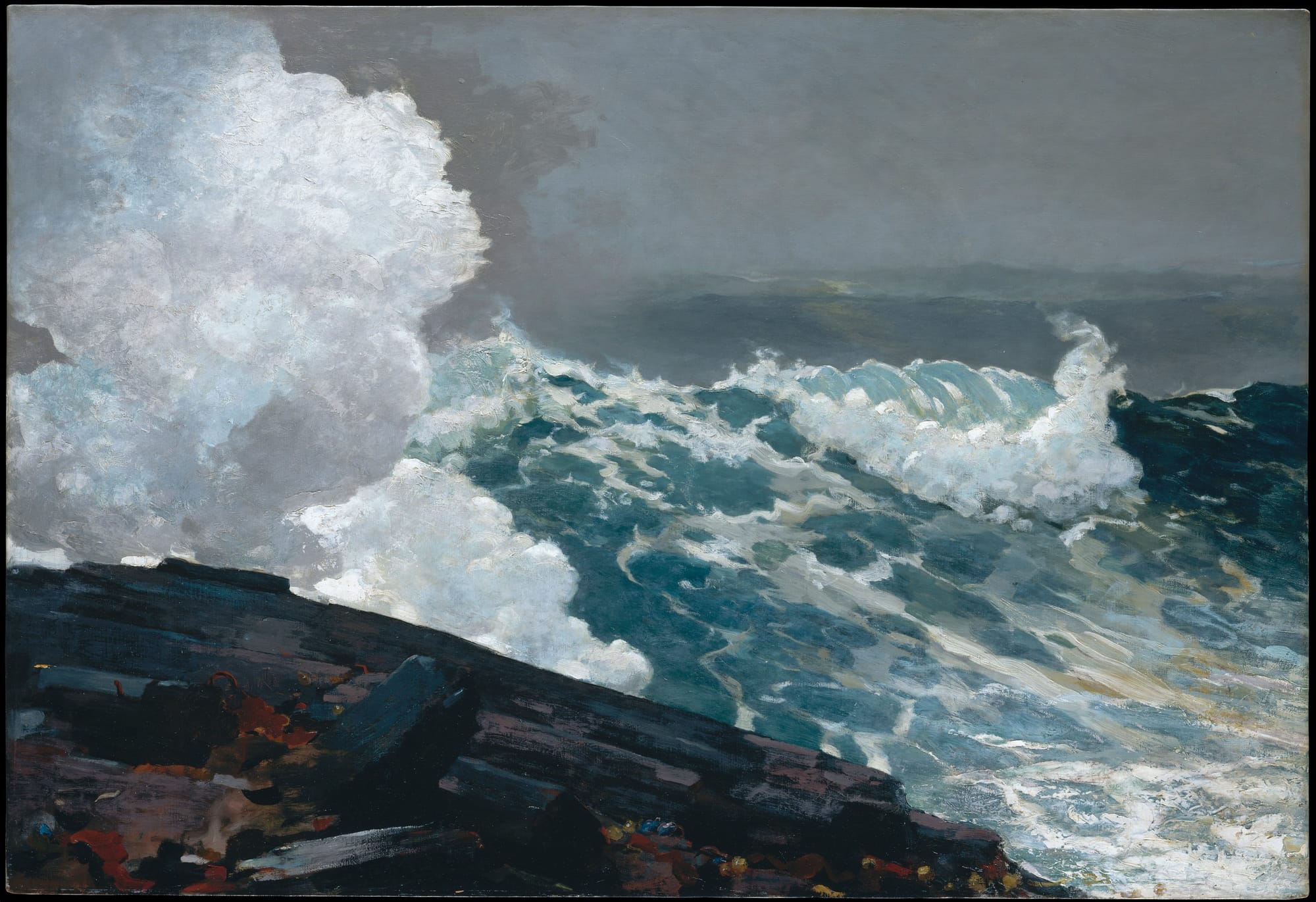The Unseen Depths of Winslow Homer's “The Gulf Stream”
In this moment of racial reckoning, we cannot continue viewing Homer's masterpiece as an apolitical seascape painting.

Somewhere off Key West, a hurricane-battered sloop drifts, dismasted, in heaving seas. A bare-chested Black man lies on its perilously tilted deck, gazing at something beyond the picture frame. He has the muscular beauty of classical statuary, the stoic resignation of a fallen gladiator facing down death. And death is coming: lashing its way toward us is the waterspout that will surely capsize his boat. In the shadowy foreground, sharks circle, on the edge of frenzy; one of them—a gape-mouthed monster erupting out of the depths—seems as if it’s about to lunge through the picture frame.
For as long as I can remember, “The Gulf Stream” (1899; reworked by 1906), the iconic painting at the heart of Winslow Homer: Crosscurrents at the Metropolitan Museum of Art in New York (on view April 11 – July 31, 2022), has played an enigmatic yet powerfully evocative role in my personal mythology. It’s a deeply, darkly polyvalent work, which explains its mesmeric spell and shifting meanings from 1906, when the Met acquired it, right up to the present.
For Homer, the deeper meaning of “The Gulf Stream” was, he claimed, the deep. “I have painted on the picture since it was in Phila & improved it very much—(more of the Deep Sea water than before),” he wrote in a 1900 letter quoted in the exhibition catalogue. His capitalization, for emphasis, hints at deeper, symbolic meanings.
Nonetheless, Homer, like most artists, was doggedly hostile to interpretations of his work.”The Gulf Stream,” he protested, was about the Gulf Stream, the fast-moving “river” of warm water in the Atlantic Ocean that flows from the Gulf of Mexico, traces the contours of the United States’ eastern seaboard, and, ultimately, splits in two on the crossing, heading toward Northern Europe on one hand and West Africa on the other.
But as the show’s co-curator Stephanie L. Herdrich makes clear in her catalogue essay, Homer’s insistence that “the subject of this picture is comprised in its title” [overemphatic italics his] and that “the boat & sharks” are “matters of very little consequence” is contrarian to the point of perversity. As an illustrator for Harper’s Magazine, he’d recorded the frontlines skirmishes and camp life of union troops in the Civil War. Vacationing in the Bahamas in later years, he’d documented, in sun-soaked watercolors bright with irony, the gulf of race and class separating the White elite from the islands’ Black underclass, for whom abolition meant little more than swapping slavery’s lash for sharecropper servitude.

In “A Garden in Nassau” (1885) and “Rest” (1885), poor Black Bahamians gaze yearningly at the paradisal gardens of the rich, fortified against them by whitewashed walls topped with glass shards sharp as a shark’s teeth. Homer started work on "The Gulf Stream" in 1899, the year Rudyard Kipling justified colonial ambitions in “The White Man’s Burden,” the year after the Spanish-American war established American dominance in the West Indies, and amid a Southern white backlash against the gains of Reconstruction characterized by Jim Crow laws and the night terrors of the Klan. The deck of the wrecked boat is strewn with stalks of sugarcane, shorthand for an exploitative industry built on slave labor.
It’s hard to imagine Homer looking at a Black man adrift in a sea of horror at the turn of the 19th century, a period which historians regard as the nadir of race relations in this country, and seeing nothing but the river beneath the sea.
Conversely, the Gulf Stream is the last thing on our minds when we look at Homer’s painting. The politics of identity dominates our moment of racial reckoning, white-supremacist backlash, and white anxiety over the Browning of America. Herdrich is in tune with our times, reading “The Gulf Stream” through the lens of colonialism, imperialism, and, of course, race.
The Gulf Stream had been essential to the traffic of human beings, accelerating the transport of slaves across the Atlantic. In Homer’s day, chattel slavery and sharks were closely linked in the public mind. One of the picture’s avowed influences, it turns out, was J.M. Turner’s 1840 painting “Slave Ship (Slavers Throwing Overboard the Dead and Dying, Typhoon Coming On),” a nightmarish evocation of the murder of 130 sick or dying Africans — thrown overboard in chains, to drown or be devoured by sharks — by the captain of the British slave ship Zong so he could file an insurance claim for human “cargo” lost at sea.
Herdrich uses the Afrodiasporic and African American experiences as magnifying glasses to reveal new ways of seeing a painting whose depths we thought we’d plumbed — yet another sign that the stately, tradition-bound Met is turning, slowly but determinedly, to face the hard truths of American history and the incendiary issues of our era. (The museum’s decision to moderate a dialogue between “The Gulf Stream” and works commenting on it elsewhere in the American Wing by Kara Walker, Kerry James Marshall, and other contemporary Black artists, is, much like its recontextualization of Jean-Baptiste Carpeaux’s 1873 sculpture “Why Born Enslaved?” in “Fictions of Emancipation: Carpeaux Recast,” timely and daring, turning old into new by restoring lost historical and contemporary context.)
And not a moment too soon: it’s been more than two decades since the New Criterion art critic and conservative culture warrior Roger Kimball issued a fatwa against politically correct overreadings of innocent seascapes that, until academic leftists got their hands on them, had been gamboling along, minding their own shark-infested business. He was especially peeved by a 1989 essay on “The Gulf Stream” whose author, the art-history professor Albert Boime, was “more concerned to declare his correct attitudes about race than to appreciate Homer’s painting in its own terms.”
It isn’t incorrect attitudes about race that make Kimball squirm, but race, period. He’d rather not discuss the Black man in the room, even though Homer’s decision to place a Black man at the center of his drama, and to portray him not from the perspective of the White gaze, with its minstrel-show caricatures and sentimentalized racist clichés, but as the doomed fisherman saw himself — dignified, strong, resolute in the face of certain death — was nothing less than radical in 1899. Writing in 1935, Alain Locke, a leading light in the Harlem Renaissance, had no doubt the “musculature and physical power” of Homer’s Black protagonist “broke the cotton-patch and back-porch tradition” and “began the artistic emancipation of the Negro subject.”
Of course, neither Kimball nor the Met curators, Herdrich and Sylvia Yount, account for subjective readings, largely because both are combatants on the battlefield of identity politics, but also because the subjective sense we make of a work of art doesn’t lend itself to outside intervention by critics and curators. At its most psychologically potent, subjective interpretation is deeply personal, translating our lived worlds into the secret symbolism of our neuroses, traumas, fetishes, and obsessions. The deepest meanings of such sensations are often inaccessible even to us, shadows circling in the unconscious.

Looking at “The Gulf Stream”, what do I see? One of those political allegories that winds up Kimball’s bowtie, to be sure: a parable about American democracy in rough seas, menaced on all sides by white supremacists, the imminent overturning of Roe v. Wade, the election of opportunistic demagogues like J.D. Vance by right-wing billionaires like Peter Thiel, the assault on congress from within by nihilist trolls like Marjorie Taylor Green, the terrifying metastasis of a Punisher cop culture accountable to no one and brutally hostile to Black and brown people and anyone to the left of the Proud Boys.
But that’s just my art-historically literate, politically engaged self — my public-facing self, if you will — encountering Homer’s painting in a cultural context, at a historical moment, and reading it in that light. My subjective impressions, on the other hand, have little if anything to do with any of these issues and everything to do with the time I almost drowned off the coast of La Jolla.
Caught in a rip tide, struggling to the point of exhaustion, I resolved to give up, to be “tucked...under one arm” of a “gray mother-wave,” like the boy in Kipling’s Captains Courageous, who when “the great green closed over him … went quietly to sleep.” Letting myself sink down, down the water column, far from sound and sunlight, I opened my mouth to swallow the sea. Seconds later I was bobbing on the surface, coughing and thrashing and yelping for help. Help came, in the guise of lifeguards on surfboards, who towed me to shore, clinging to a plastic float.
I’ve never forgotten what it was like to hang suspended in the bosom of the sea, waiting for it to fold me into its cold embrace.

Stare at the Pacific long enough, as I used to do in the endless summers of my San Diego youth, and you’ll feel your sense of self dwindling to a pinprick and, finally, swallowed up, like Pip, the African American cabin boy in Melville’s Moby-Dick. He falls overboard and is rescued, but not before his time adrift, alone in a measureless vastness, has driven him mad: “The sea had jeeringly kept his finite body up, but drowned the infinite of his soul.”
Is that what Homer, who spent so much of his life staring at the ocean — in Gloucester, Massachusetts; in Cullercoats, England (on the North Sea, near Newcastle); in the Bahamas, in Cuba, in Bermuda, at Prouts Neck, Maine — was trying to capture: the sensation of losing your soul to the deep blue sea?
His excitement at having “improved” the painting “very much” by adding “more of the Deep Sea water than before” betrays the creative fervor of an artist wrestling with a paradox: How can you reveal the unseen depths of a thing if all you can see is its ever-changing surface? (The Gulf Stream, remember, is a river of warm water below the ocean’s surface, its banks and bottom bounded by colder water.) Yet somehow, in “The Gulf Stream,” he does just that. It’s the work of a man who knew that the sea is uncanny, not a being but inescapably a presence, indifferent to you, me, and all humanity, its crashing waves and hissing foam the untranslatable speech of leviathans, its fathomless depths the last refuge of mysteries.





